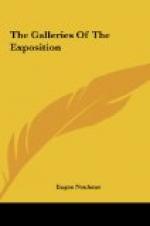Of all the foreign nations represented, with the exception of Japan and China, none possesses so distinct a national character as the art of Sweden. I cannot help expressing my personal conviction that it is the best national section in the whole exhibition, showing, as it does, not merely easel painting, but also many splendid examples of so-called applied art, which often permits one to get a deeper insight into the standard of art of a people than easel painting alone. It is true that certain examples of painting in the French or American sections are more appealing to us, but in the light of the national characteristics of the people and the country, Swedish art has a very definite quality, consistently shown. Their work has a robustness which has nothing to do with the salon aspect of the art of southern Europe, particularly France. In fact it is almost opposed to the art of the Romanic races, and distinctly apart from the art of Germany. It is fortunate Sweden could make such a splendid showing without the support of the art of such a man as Anders Zorn, who, while decidedly Swedish, is after all much of a cosmopolitan painter, with all the earmarks of an international training. The art of the most artistic of all people, that of the French, is often said to have a decadent note. In comparison, Swedish art may be said to be absolutely robust, healthy, and vigorous, without being coarse. To those who pretend to find a certain physical brutality in Swedish art, I should like to point out that the most delicate pictures in the entire exhibition — those of John Bauer — are the chief asset of the Swedish exhibit. The great variety of the work in this section makes it very interesting, and permits, as said before, close insight into many phases of modern art.
The most pronounced individualities in the collection, covering all fields, are Bruno Liljefors, Gustav Fjaestad, Carl Larsson, John Bauer, Mr. and Mrs. Boberg, David Edström, Mas-Olle, and others too numerous to mention. Bruno Liljefors for many years has been known internationally as one of the best of animal painters, and particularly of sea fowl. He has had the experience common to many great artists, of working himself up from very academic beginnings to a wonderful personality of marked freedom. His canvas of the nine wild swans is perhaps the biggest single picture in the entire Exposition. It is immediately suggestive of a decoration, and to think of it in that sense, as a part of a wall seen from a great distance, makes one almost tremble with expectation. This truly great picture is a rhythmic masterpiece. The placing of these graceful swans is marvelously well studied from the point of view of design, yet none the less does an expression of reality animate these divine birds. There is something about swans which puts them even above the king of birds, the eagle. I can conceive of men killing any animal, but the thought of one of these noble birds falling victim




